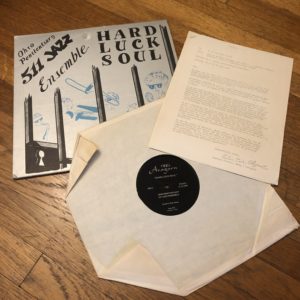Prison rock, blues and soul songs/albums are a genre unto themselves but prison jazz albums aren’t nearly as common. This early ’70s album is one of the rare exceptions. Recorded by inmates at the Ohio State Penitentiary in Columbus, OH, Hard Luck Soul, despite its name, is a modal/spiritual jazz album, comprising of just four songs, all between ~5-10 minutes in length.
The background behind this album was chronicled when it was reissued by UK’s Jazzman Records in 2012; I’ll just quote a bit from what I assume were the reissue’s liner notes:
“Band leader Reynard Birtha was originally from North Carolina, where he played in a band called The Outer Limits… [He] ended up in Cincinnati, and through a mutual passion for music, he met fellow musician Logan Rollins, nephew of jazz legend Sonny Rollins. They became friends and jammed at local clubs before both ended up in the State penitentiary, for reasons not entirely clear. At the time it was customary for musicians to visit the prison and give concerts…these visits were not only a source of entertainment for the prisoners, but they were also a source of inspiration for musicians like Reynard. He and Logan formed the 511 Jazz Ensemble, incorporating the remnants of the prison Pit Band. Reynard recalls that “the number 511 was the P.O. box address of the prison, and we would perform in the yard during every holiday, while the prisoners marched around and got their food.”
I was very fortunate to luck into an original copy of the album, signed by all the inmates/players but what was mostly notable was that it also came with a mimeographed two-sheet that was a memo sent by a trio of inmates to the prison warden to propose the creation of “‘511’ Jazz Society,” which was a different entity from the 511 Jazz Ensemble. To summarize:
The ‘511’ Jazz Society was originally proposed in November of 1970 by a trio of inmates (Cartier, Cook and Chappell). They were fans of the “Jazz Roundtable” radio show, put together by the Columbus Jazz Society, for air on WOSU (which I assume was the college radio station at Ohio State Univ.). The three inmates wrote:
“Music-wise, Columbus is predominantly “Country-Western” oriented; consequently, we devotee’s [sic] of jazz, America’s only original “ART FORM” suffer from lack of exposure to our preferred medium of musical entertainment.”
(Is there a racial subtext here? Oh my yes.)
Therefore, Cartier, Cook and Chappell proposed the formation of a jazz appreciation group in the prison, aka the ‘511’ Jazz Society, that would regularly meet to “hear the latest innovations in this particular field of the ‘Musical Arts.'” They suggested that they would hold “panel discussions between the members…concerning the artist, his style of playing, improvisational and expressionistic ability; the general progress of Jazz, harmonically and culturally, since its inception early in this century.”
They had already gotten permission from Rabbi Zelizer to hold society meetings inside the prison chapel (“either Monday’s or Friday’s… From our point of view, Monday’s would be the most suitable.”)
On the second page is a list of rules for the Society, established after the warden had given his permission. One of the rules stated “25 members should be the quota. As a member leaves the institution or drops out, another man can fill the vacancy.” The inaugural group of 25 members, listed by inmate number and surname, are included.
Best as I can tell, almost none of the players in the 511 Jazz Ensemble were part of the inaugural Jazz Society (the only exception could be George Williams, lead guitar, as there was a “Williams” listed as a Society member). However, it’s entirely possible that the Jazz Ensemble players joined the Society later; the liner notes for the reissue don’t mention the Jazz Society at all which is curious but it’s possible that Ensemble leader Reynard Birtha simply didn’t recall the Society some 40 years after the album had been recorded. In any case, this kind of random ephemera that sometimes comes with vintage records is one of the great things about collecting said vintage records.
And in any case, even without it, this was still a wonderful find. The music by the Ensemble makes for a sublime end-to-end listen. There’s a lot of atmosphere in the sound that I assume is a product of the acoustics of the chapel they recorded it in and that enhances my experience of listening to it, especially since, overall, the engineering is pretty solid for an album that wasn’t taped inside a proper studio. I dig all four tracks but the ~10 minute songs that begin each side – “Psych City” and “Counterry Bosa Davan” – are my favorites given how they unfurl over time. Enjoy!



Awesome post! There was a recent Ear Hustle all about music recorded in San Quentin. Would be curious to get your review of Lucky Guy.
https://www.earhustlesq.com/music
Thanks as always!